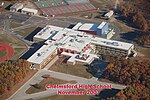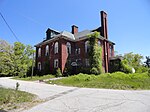Chelmsford Center Historic District
Chelmsford, MassachusettsHistoric districts in Middlesex County, MassachusettsHistoric districts on the National Register of Historic Places in MassachusettsMiddlesex County, Massachusetts Registered Historic Place stubsNRHP infobox with nocat ... and 1 more
National Register of Historic Places in Middlesex County, Massachusetts

The Chelmsford Center Historic District is a historic district encompassing the historic heart of the town of Chelmsford, Massachusetts. It extends from the town's central square in the east, where the intersection of Billerica Road and Chelmsford Street is located, west beyond the junction of Littleton and North Roads with Westford Street, and from there north along Worthen Road. It includes the area that was the 17th-century heart of the town, including its common and first burying ground, and has been the town's civic heart since its founding.The district was added to National Register of Historic Places in 1980.
Excerpt from the Wikipedia article Chelmsford Center Historic District (License: CC BY-SA 3.0, Authors, Images).Chelmsford Center Historic District
Westford Street,
Geographical coordinates (GPS) Address Nearby Places Show on map
Geographical coordinates (GPS)
| Latitude | Longitude |
|---|---|
| N 42.598055555556 ° | E -71.354166666667 ° |
Address
Westford Street
Westford Street
01824
Massachusetts, United States
Open on Google Maps










